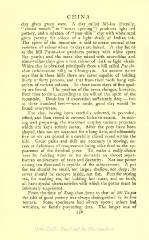Page 438 - Oriental Series Japan and China, Brinkly
P. 438
CHINA
Apc"loactylteorsgyei,dveamsnodugtarehmei"nxtowurarr"ees.oefcre"tpeocaplrea-ynsiknicngal""l)ecdlparMyoidw-uiktceheuswhl(ilitigtehetrsaalrlneydd,
gives pottery the colour of a light shade of Indian ink.
The spirit of the mountain is said to create several other
Avarieties of colour when its clays are baked.
clay found
at the hill Twan-shan produces pottery with white spots
like pearls ; and the same clay mixed with azure-blue and
stone-yellow clays give a rust colour of dark or light shade.
White clay is obtained principally from a hill called Pai-shi-
Anshan (white-stone hill), in Chiang-yin. ancient writer
says that in these hills there are caves capable of holding
thirty or forty persons, and that from their roofs hang stal-
actites of various colours. In these caves clays of fine qual-
ity are found. The position of the caves changes, however,
from time to time, according to the will of the spirit of the
mountain. Doubtless if excavation sufficiently deep two
or three hundred feet were made, good clay would be
found everywhere.
The clay, having been carefully selected, is pounded,
sifted, and then stored in covered holes to season. In mix-
ing and preparing, the workmen employ various processes
which are kept strictly secret. After the pots have been
shaped, they too are seasoned for a long time, and ultimately
five or six are placed in a carefully closed vessel within the
kiln. Great pains and skill are necessary in stoving, ex-
cess or deficiency of temperature being alike fatal to the ap-
pearance of the finished piece. To make a really choice
vase for holding water or tea demands an almost super-
human endowment of taste and dexterity. Not one potter
Aamong ten thousand is capable of the achievement.
pot
for tea should be small, not large ; shallow, not deep ; its
cover should be concave inside, not flat. Pots for storing
tea, for washing tea, for holding hot water, and so forth,
all have special characteristics with which the potter must be
intimately acquainted.
From the time of Kung-chun down to that of Shi Ta-pin
the p&te of good pottery was always distinguished by its fine
texture. Some specimens had silvery spots ; others had
wrinkles, or faintly projecting dots. The longer one of
356

